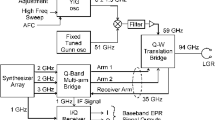Abstract
Reasons for unsatisfactory operation of the superheterodyne spectrometers at increased microwave power are considered. Recommendations for designing the superheterodyne microwave bridge of the EPR spectrometer working at the microwave power of about hundreds of milliwatt are given. These recommendations allow one to develop the spectrometer comparable to those with modulation of resonant conditions concerning reliability, stability and simplicity of operation. The experimental prototype of the coherent microwave bridge of the X-band superheterodyne EPR spectrometer with the intermediate frequency of 100 MHz is described. The microwave circuit of the bridge is assembled using microstrip hybrid integrated circuits and requires no adjustment in operation. The microwave Gunn-diode generators with the electronic tuning stabilized by dielectric resonators are used. The dynamic range of 54 dB at the maximum power of 40 mW is reached. As the microwave power increases up to the maximum value, no tendency to the degration of sensitivity equal to 5·10−11 W at the 40 MHz band is noticed.
Similar content being viewed by others
References
Schweiger A. in: 2nd Conf. Mod. Meth. Radiofrequency Spectroscopy, pp. 68–85. Reinhardsbrunn, Nov. 11–15 1985.
Teaney D.T., Klein M.P., Portis A.M.: Rev. Sci. Instrum.32, 721 (1961)
Maron R.S., Poznyak A.L., Shushkevitch S.S. in: Apparatura dlya Issledovaniya Elektronnogo Paramagnitnogo Rezonansa (in Russian), p. 140. Leningrad: Energiya 1968.
Poole Ch.P., Jr. in: Electron Spin Resonance, New York: John Wiley & Sons 1967.
Kornilov S.A., Savshinski V.A., Uman S.D. in: Shumi Klistronnih Generatorov Maloy Moshnosty (in Russian), p. 200. Moskva: Sov. Radio 1972.
Buckmaster H.A., Dering J.C.: J. Sci. Instrum.43, 554 (1966)
Stelmakh V.F., Tvirko L.V.: Prib. Techn. Exper.5, 131 (1986)
Strandberg M.W.P.: Rev. Sci. Instrum43, 307 (1972)
Roger G., Blanc C., More C.: J. Phys. E: Sci. Instrum.14, 335 (1981)
Buckmaster H.A., Hansen C.H.: J. Magn. Reson.46, 521 (1982)
Gassanov L.G., Lipatov A.A., Markov V.V., Moglichenko N.A. in: Tverdotelnie Ustroistva SVCh v Tekhnike Svyazi (in Russian), p. 288. Moskva: Radio i Svyaz 1988.
Manassewitsch V. in: Frequency Synthesizers. Theory and Design. New York: John Wiley & Sons 1976
Williams A.B. in: Designer’s Handbook of Integrated Circuits. New York: McGraw-Hill Book Company 1984
Rizhkov A.V., Popov V.N. in: Sintezatori Chastot v Tekhnike Radiosvyazi (in Russian), p. 264. Moskva: Radio i Svyaz 1991.
Dobrov V.A., Drapkin V.Z., Zaitsev K.V., Makarov Yu.A., Maron R.S., Serdyuk A.S., Uman S.D., Yanchurov V.A.: Prib. Techn. Exper.5, 133 (1986)
Lesniewski P., Hyde J.S.: Rev. Sci. Instrum.61, 2248 (1990)
Author information
Authors and Affiliations
Rights and permissions
About this article
Cite this article
Rokeakh, A.I., Batin, A.M., Makhnev, O.B. et al. Microstrip superheterodyne coherent microwave bridge. Appl. Magn. Reson. 9, 441–457 (1995). https://doi.org/10.1007/BF03162354
Received:
Issue Date:
DOI: https://doi.org/10.1007/BF03162354




